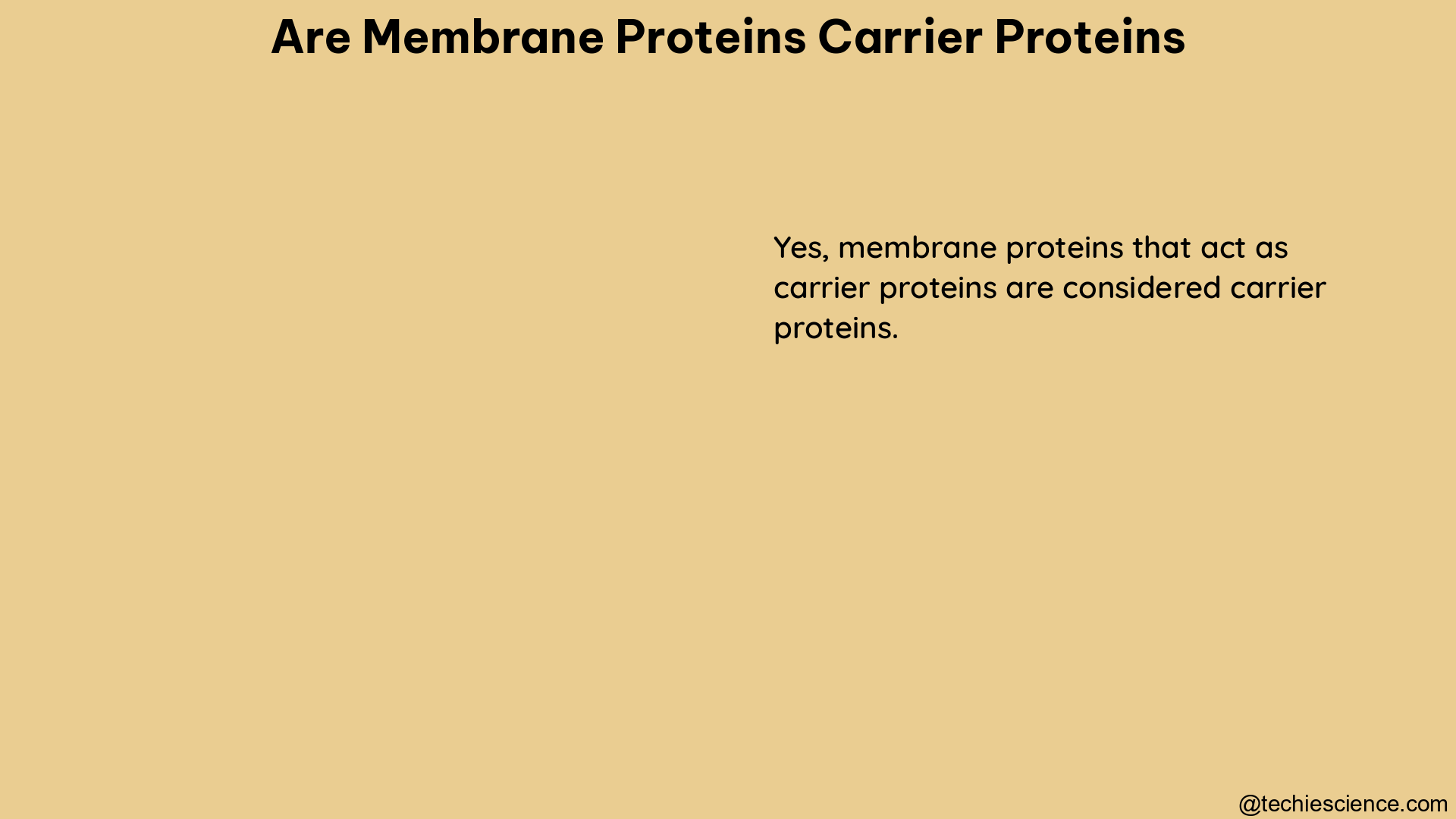Membrane proteins and carrier proteins are essential components of biological membranes, playing crucial roles in the transportation of molecules across these barriers. While both types of proteins are involved in membrane transport, they have distinct characteristics and functions. This comprehensive guide will delve into the intricacies of membrane proteins and carrier proteins, providing a detailed understanding of their roles, mechanisms, and importance in various biological processes.
Understanding Membrane Proteins
Membrane proteins are a diverse class of proteins that are embedded within or associated with the lipid bilayer of biological membranes. These proteins serve a wide range of functions, including:
- Transport: Membrane proteins facilitate the movement of molecules, ions, and other substances across the membrane, either through passive diffusion or active transport.
- Signaling: Membrane proteins act as receptors, transducing extracellular signals into intracellular responses, and as signal transducers, relaying information between different cellular compartments.
- Structural Support: Some membrane proteins provide structural integrity to the membrane, contributing to the overall organization and stability of the cell.
- Enzymatic Activity: Certain membrane proteins possess enzymatic functions, catalyzing various biochemical reactions within the membrane or at the membrane-cytoplasm interface.
Membrane proteins can be classified into several categories based on their structural and functional characteristics, such as integral membrane proteins, peripheral membrane proteins, and lipid-anchored membrane proteins.
Carrier Proteins: Facilitating Membrane Transport

Carrier proteins, a specific type of membrane protein, are responsible for the facilitated transport of molecules across biological membranes. These proteins bind to specific solutes and undergo conformational changes to translocate the solutes from one side of the membrane to the other.
Types of Carrier Proteins
Carrier proteins can be classified into two main categories based on the type of transport they facilitate:
- Simple Diffusion Carriers: These carriers facilitate the passive movement of molecules down their concentration gradient, from a region of high concentration to a region of low concentration.
- Facilitated Diffusion Carriers: These carriers use protein channels to aid in the movement of molecules, also down their concentration gradient.
An example of a facilitated diffusion carrier is the glucose transporter (GLUT), which facilitates the transport of glucose into cells.
Carrier Protein Mechanism
The process by which a carrier protein transfers a solute molecule across the lipid bilayer resembles an enzyme-substrate reaction. Each carrier protein has one or more specific binding sites for its solute (substrate). The carrier protein undergoes reversible conformational changes that alternately expose the solute-binding site on one side of the membrane and then on the other, effectively transporting the solute across the membrane.
The rate of transport, known as Vmax, is characteristic of the specific carrier and reflects the rate at which the carrier can flip between its two conformational states. Additionally, each transporter protein has a characteristic binding constant for its solute, Km, which represents the concentration of solute when the transport rate is half its maximum value.
Factors Affecting Carrier Protein Function
The rate of diffusion, both simple and facilitated, is regulated by several factors, including:
- Concentration Gradient: The difference in solute concentration between the two sides of the membrane drives the direction and rate of transport.
- Particle Size and Charge: The size and charge of the transported molecules can influence their ability to pass through the carrier protein’s binding site and channel.
- Temperature and Viscosity: Changes in temperature and the viscosity of the medium can affect the kinetics of the carrier protein’s conformational changes and the overall rate of transport.
Active Transport and Other Membrane Transport Mechanisms
In addition to carrier proteins, cells employ other mechanisms for active transport across membranes, including:
- Coupled Carriers: These carriers couple the uphill transport of one solute to the downhill transport of another, allowing the cell to move molecules against their concentration gradient.
- ATP-Driven Pumps: These membrane proteins use the energy released from the hydrolysis of ATP to drive the uphill transport of molecules across the membrane.
- ABC Transporters: This family of transport ATPases uses the energy of ATP hydrolysis to import or export certain small molecules, playing a crucial role in various physiological and pathological processes.
Importance and Applications of Membrane Proteins and Carrier Proteins
Membrane proteins and carrier proteins are essential for a wide range of biological processes, including:
- Cell Signaling and Communication: Membrane proteins act as receptors and signal transducers, enabling cells to respond to extracellular stimuli and coordinate their activities.
- Nutrient and Ion Homeostasis: Carrier proteins facilitate the transport of essential nutrients, ions, and other molecules across membranes, maintaining the appropriate concentrations within cells and tissues.
- Drug Transport and Pharmacology: Understanding the mechanisms of membrane proteins and carrier proteins is crucial for the development of targeted drug therapies, as these proteins can influence the absorption, distribution, and elimination of drugs.
- Diagnostics and Biomarkers: Membrane proteins and carrier proteins can serve as valuable biomarkers for the diagnosis and monitoring of various diseases, as their expression and function can be altered in pathological conditions.
Conclusion
Membrane proteins and carrier proteins are indispensable components of biological membranes, playing pivotal roles in the transportation of molecules across these barriers. By understanding the intricate mechanisms and functions of these proteins, researchers and clinicians can gain valuable insights into a wide range of biological processes and develop innovative strategies for addressing various health-related challenges.
References:
- Carrier Protein – an overview | ScienceDirect Topics
- Membrane Transport – BIOLOGY FOR LIFE
- Getting Across the Cell Membrane: An Overview for Small Molecules …
- Topic 1.4 Membrane Transport
- Carrier Proteins and Active Membrane Transport – NCBI

I am Trisha Dey, a postgraduate in Bioinformatics. I pursued my graduate degree in Biochemistry. I love reading .I also have a passion for learning new languages.
Let’s connect through linked in: